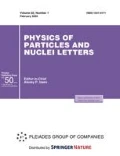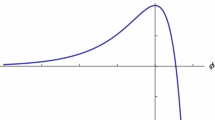Abstract
The dynamics of any spherical cosmology with a scalar field (‘scalaron’) coupling to gravity is described by the nonlinear second-order differential equations for two metric functions and the scalaron depending on the ‘time’ parameter. The equations depend on the scalaron potential and on arbitrary gauge function that describes time parameterizations. This dynamical system can be integrated for flat, isotropic models with very special potentials. But, somewhat unexpectedly, replacing the independent variable t by one of the metric functions allows us to completely integrate the general spherical theory in any gauge and with arbitrary potentials. In this approach, inflationary solutions can be easily identified, explicitly derived, and compared to the standard approximate expressions. This approach is also applicable to intrinsically anisotropic models with a massive vector field (‘vecton’) as well as to some non-inflationary models.
Similar content being viewed by others
References
A. T. Filippov, “On solving dynamical equations in general homogeneous isotropic cosmologies with scalaron,” Theor. Math. Phys. 188, 1069–1098 (2016).
A. T. Filippov, “Exact solutions of (1+1) dimensional dilaton gravity coupled to matter,” Mod. Phys. Lett. A 11, 1691–1704 (1996).
A. T. Filippov, “Integrable models of (1+1)-dimensional dilaton gravity coupled to scalar matter,” Theor. Math. Phys. 146, 95–107 (2006).
V. de Alfaro and A. T. Filippov, “Dimensional reduction of gravity and relation between static states, cosmologies and waves,” Theor. Math. Phys. 153, 1709–1731 (2006).
V. de Alfaro and A. T. Filippov, “Multi exponential models of (1+1) dimensional dilaton gravity and Toda–Liouville integrable models,” Theor. Math. Phys. 162, 34–56 (2010).
A. T. Filippov, “Integrals of equations for cosmological and static reductions in generalized theories of gravity,” Phys. Part. Nucl. Lett. 11, 1–10 (2014).
A. T. Filippov, “On Einstein–Weyl unified model of dark energy and dark matter,” arXiv:0812.2616.
A. T. Filippov, “Weyl–Eddington–Einstein affine gravity in the context of modern cosmology,” Theor. Math. Phys. 163, 753–767 (2010).
A. T. Filippov, “Affine generalizations of gravity in the light of modern cosmology,” Proc. Steklov Inst. Math. 272, 107–118 (2011).
A. T. Filippov, “General properties and some solutions of generalized Einstein-Eddington affine gravity I,” arXiv:1112.3023.
A. T. Filippov, “Unified description of cosmological and static solutions in affine generalized theories of gravity: vecton–scalaron duality and its applications,” Theor. Math. Phys. 177, 1556–1578 (2013).
E. M. Lifshitz and I. M. Khalatnikov, “Investigations in relativistic cosmology,” Adv. Phys. 12, 185–249 (1963).
V. Mukhanov, Physical Foundations of Cosmology (Cambridge Univ. Press, Cambridge, NY, 2005).
D. Gorbunov and V. Rubakov, Introduction to the Theory of the Early Universe: Cosmological Perturbations and Inflationary Theory (World Scientific, Singapore, 2010).
A. Linde, “Inflationary cosmology after Planck 2013,” arXiv:1402.0525.
J. Martin, “The observational status of cosmic inflation after Planck,” arXiv:1502.05733.
M. Cavaglia, V. de Alfaro, and A. T. Filippov, “Hamiltonian formalism for black holes and quantization,” Int. J. Mod. Phys. D 4, 661–672 (1995); “A Schrödinger equation for mini-universes,” Int. J. Mod. Phys. A 10, 611–634 (1995).
J.-L. Lehners, “Classical inflationary and ekpyrotic universes in the no-boundary wave function,” arXiv:1502.00629.
Author information
Authors and Affiliations
Corresponding author
Additional information
The article is published in the original.
Rights and permissions
About this article
Cite this article
Filippov, A.T. A fresh view of cosmological models describing very early universe: General solution of the dynamical equations. Phys. Part. Nuclei Lett. 14, 298–303 (2017). https://doi.org/10.1134/S1547477117020091
Received:
Published:
Issue Date:
DOI: https://doi.org/10.1134/S1547477117020091




